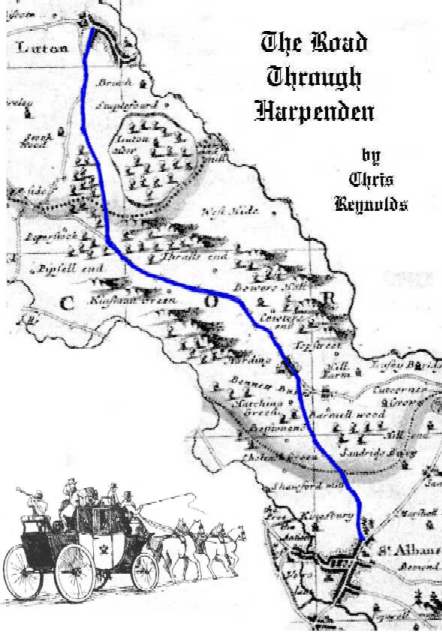|
The Road Through Harpenden |
|
The Road Through Harpenden |

Map: edited from Sellars 1676 - From Four County Maps of
Hertfordshire
Mail Coach: From Coaching Days in and around St Albans, by D. E.
Howell
This talk looks into the history of the road between St Albans and Luton, passing through Harpenden (or Harden as it was also known), from the earliest available records until the start of the 20th Century. It concentrates on the southern part of the route, as much of the information was collected as part of a study of Bernards Heath, St Albans.
The beginnings of the road are lost in the mists of time but it is possible to speculate. It is clear that there would have been a track from the Iron Age town of Verlamion (later the Roman Verulamium) towards the iron age towns at Wheathampstead and Colchester. There is no evidence to indicate whether there was a track branching off along the current Harpenden Road, St Albans, line but it would be interesting to know what happens where the road crosses Beech Bottom, a massive Iron Age Ditch which used to run further south west. Was a crossing point left when the ditch was constructed in Iron Age times or was it filled in later to make a crossing?
There is some evidence of people in the Harpenden area in Roman times but none for the original track between St Albans and Harpenden, although it has been suggested that the road north from Harpenden may be or Roman origin. From these times people presumably left on the main Roman road towards Colchester, and this became Everlasting Lane, which may well have been the start of the way towards Harpenden in the Dark Ages. As the Abbey became more important, and the numbers of pilgrims increased changes were made to the roads to ensure travellers passed close by the Abbey. St Peters Church was built in 948, presumably to welcome pilgrims from the North and East, and is seems likely that those coming through Harpenden would have crossed Bernards Heath on their way via St Peter's to the Abbey.
I am dubious about some of the information about the minor Roman Roads in the area given in Roman Roads in the South-East Midlands by The Viatores (Victor Gollanz, 1964). Their interpretation of the line of the road from Verulamium towards Sandridge is appears to be the result of wishful thinking in the area of Bernards Heath, and is incompatible with later archaeological discoveries in the Folly Lane area of St Albans.
<<< Back <<< Index >>> Next >>>
If you can add to the information given above please tell me.